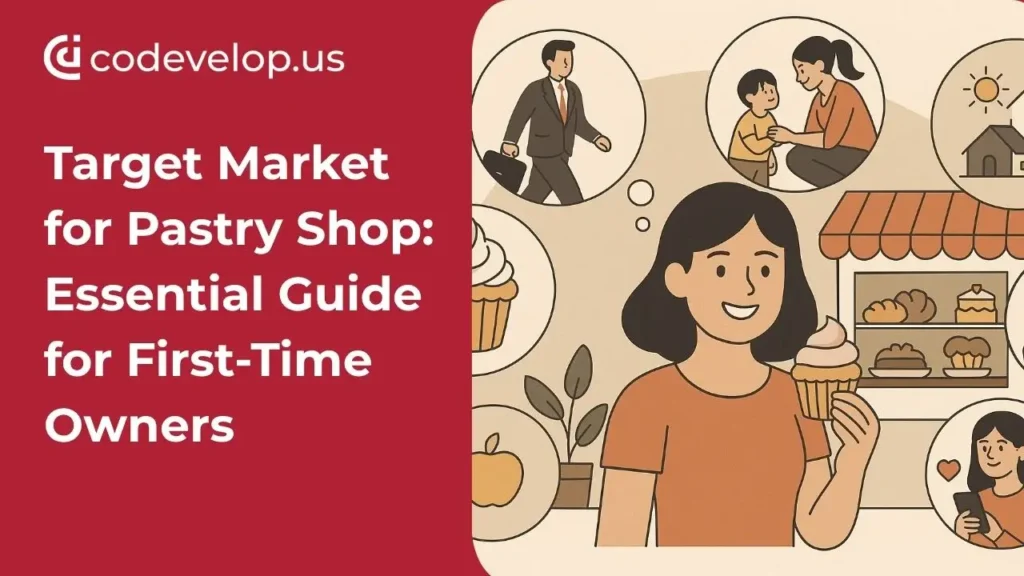The success of your pastry shop relies on discovering the appropriate target market, particularly if it is your first business. The best cakes in the world cannot sell by themselves without connecting with the correct audience.
The target market of a bakery is very important. It allows you to promote desserts to particular individuals at the right time in ways they like. Knowing your perfect customers enables you to tailor-make your baked products, services, and offers for their unique requirements. A proper understanding of the marketplace from the beginning can provide an advantage over other competitors. Clever focusing might make customers spend around $400 each year at your store and could attract 5-10 new recommendations every year.
In this article, you will understand how to divide customers according to their age group, gender, lifestyle, and behavior. These are important elements that form your marketing plan and determine the success of your store. You will also discover successful methods to interact with various customer groups, as well as learn from frequent errors made by new bakery owners.
Understanding the Target Market for a Pastry Shop
Your bakery’s success starts with knowing your customers well. Good market analysis helps you find what excites your patrons and turns casual visitors into loyal fans.
Why knowing your audience matters
For a pastry shop to succeed in the busy market today, it is important to know about its walk-in customers. Wise customer segmentation helps direct your marketing efforts correctly, which increases sales and makes every penny spent on ads more valuable. Recognizing various groups of customers allows you to tailor your baked products and services according to their requirements.
Customer feedback shapes key decisions about new products, store layout, and better service. Your menu that matches what customers expect builds lasting connections. These connections bring repeat business—the cheapest sales you’ll ever make.
How the target market affects product and pricing
Your target market shapes what you bake and how you price it. Success in the bakery business isn’t about having the best bread. It’s about finding people who value quality enough to pay more and keep coming back. Quality-conscious customers don’t mind higher prices when they see superior ingredients and unique flavors.
A pastry shop near office buildings can attract steady morning traffic with pre-order breakfast boxes and rewards for daily coffee-pastry combos. Your marketing ideas should line up with specific business goals and what customers really expect.
Common mistakes first-time owners make
New owners often skip proper market research before opening. They miss key details about their potential customers’ priorities and needs. They think they know what customers want without asking them. This creates a gap between what they sell and what people just need.
Some bakery owners put too much focus on a few items while missing other products that could sell well. The solution is simple – let customers pick their favorites from various options.
Location can make or break your pastry shop’s success. People avoid businesses in poor locations, which hits your revenue hard.
Types of Customer Segmentation for Pastry Shops
Your pastry shop’s customers can be grouped based on shared traits that help you target your marketing better. This way, you’ll recognize your customer base’s unique tastes and priorities and create strategies that really connect.
Demographic segmentation
Demographics divide customers into categories according to age, family size, and job. Every category has unique preferences–younger clients usually desire treats that look good on Instagram, whereas older ones prefer traditional comfort foods such as whole-grain bread. Your menu can be tailored depending on your patrons’ income levels and financial capability in order to satisfy their desires as well as achieve your business objectives.
Psychographic segmentation
This approach looks at your customers’ lifestyle priorities and values that shape their buying choices. Some customers love handcrafted, artisanal pastries, while others look for organic ingredients. Psychographic groups include:
- Customers who care about sustainability and eco-friendliness
- People who need convenience and time-saving options
- Health-conscious individuals
- Adventure seekers who love trying new flavors
These motivations help you connect with your customers’ identities beyond just selling products.
Geographic segmentation
Location plays a big role in grouping customers. People in the same area often need similar things—city folks might want quick meal options, while rural customers usually prefer home-style treats. Weather substantially affects choices, too, with warmer areas favoring different items than colder regions. Your target area could be as small as a neighborhood or as large as multiple regions, depending on your business reach.
Behavioral segmentation
The ways customers behave reveal their interaction with your store – what things they purchase, how frequently they come by, and the habits of their expenditure. Understanding your regular clientele allows you to appreciate their loyalty through punch cards that offer free goodies after a certain number of purchases. By examining spending trends, you can establish pricing approaches suitable for various budgets, ensuring that your promotional activities are advantageous to both your enterprise and the consumers.
Examples of Target Market Segments for a Bakery Business
A successful pastry shop serves specific customer segments that have unique needs and priorities. Your offerings need customization based on these distinct groups.
Morning commuters
Morning commuters are the backbone of daily bakery traffic and cash flow. They buy small, high-margin items during morning rushes. Their buying habits focus on speed and convenience rather than price. Quick, reliable transactions, efficient service, and easy access matter most to them. John Dough Bakery Express at Downers Grove Main Street train station serves up to 200 commuters by 9 a.m.. Morning traffic patterns have moved about 30 minutes later than pre-COVID times.
Health-conscious buyers
Health-conscious buyers want whole-grain, low-sugar, and specialty health products. Research shows 71% of Gen Zers and 58% of Millennials take a proactive approach to health prevention. Clean labels, natural ingredients, and functional benefits like added protein or fiber matter to these customers. They want healthier options but expect their treats to taste delicious.
Parents and children
Families are vital to bakery success. Nearly 59% of parents balance healthy meals while allowing treats. Younger millennial parents (66%) follow this approach more than Gen X parents (53%). Current options leave parents unsatisfied – 9 out of 10 would buy healthier versions of baked goods. Cookies present the best chance, showing a 24-point gap in customer satisfaction surveys.
Special occasion customers
Special occasion customers look for custom cakes and specialty items for birthdays, weddings, and celebrations. Medium to high budgets are common, and they value high-quality ingredients and customized service. Quality presentation and uniqueness matter more than speed or convenience to these buyers.
Local residents
Local neighbors visit bakeries for daily or weekly purchases with different budgets. Fresh bread, rolls, and traditional pastries top their list. Community outreach through local food festivals, event sponsorships, or workshops helps turn your bakery into a beloved neighborhood spot.
Dietary-restricted individuals
This expanding group of customers has particular requirements such as sensitivity to gluten (which impacts around 6% of people in the US), restrictions related to dairy, or preferences for vegan diets. Food allergies affect approximately 1-2% of adults and between 4-8% of children. For these specific customers, it is most important that there are clear labels on food products, dedicated spaces for preparation that avoid cross-contamination, and delicious substitutes available.
How to Reach and Engage Your Ideal Customers
Your pastry shop’s success depends on turning potential customers into loyal patrons after identifying your target market.
Use of social media and digital platforms
Social media has become essential for pastry shops in our visually-driven world. Your digital presence can make a real difference – studies show 74% of people visit bakeries they follow online. Instagram and Facebook should be your main focus. Beautiful pastry photos and behind-the-scenes content will entice followers and help build authentic connections.
Instagram proves perfect for bakeries, with 90% of its 2 billion users following businesses. Facebook remains a powerhouse platform with over 3 billion monthly active users. You can boost engagement by running polls, hosting contests, and quickly responding to comments.
In-store promotions and sampling
Sample offerings can boost your sales by 42% compared to items without samples. People naturally love free treats – 73% of customers buy products after trying them first. A simple counter display with samples creates immediate interest and drives purchases.
Strategic sample timing during busy hours pays off. About 35% of customers who try samples make purchases that same day. The impact goes further – 24% switch to buying the sampled product instead of their usual choice.
Community events and partnerships
Local community involvement creates lasting connections. You can host fun tastings, teach baking classes, or team up with nearby businesses. Your participation in farmers’ markets or charity events shows real community support.
Partnership possibilities are endless. Team up with coffee shops to create “coffee and cupcake” deals or work with food bloggers to expand your reach. You might also connect with party supply stores to create win-win promotions.
Loyalty programs and CRM tools
Smart reward systems turn casual buyers into raving fans. Digital punch cards, point systems, and special offers recognize repeat customers. These loyal customers become natural brand ambassadors who spread the word about your business.
CRM software tracks customer priorities across Google, Yelp, and social platforms. Beyond standard rewards, you can offer birthday treats, referral bonuses, or early access to new menu items. Personal touches make customers feel special and build lasting relationships.
Conclusion
The success of your pastry shop depends on identifying and understanding your ideal target market. Effective customer segmentation—based on demographics, lifestyle, location, and behavior—helps you create products, pricing, and promotions that truly connect. Whether you’re catering to busy commuters, health-conscious buyers, or families seeking fresh treats, knowing what each group values ensures your bakery stands out.
Strong customer relationships build long-term success. Loyal customers spend more, refer friends, and strengthen your community presence. Avoiding common mistakes like skipping market research or limiting product variety starts with understanding real customer needs. When your bakery’s marketing speaks to the right people at the right time, your business naturally grows and thrives.
Want to enhance your online presence? Contact Codevelop, Portland’s best digital marketing agency, today!


